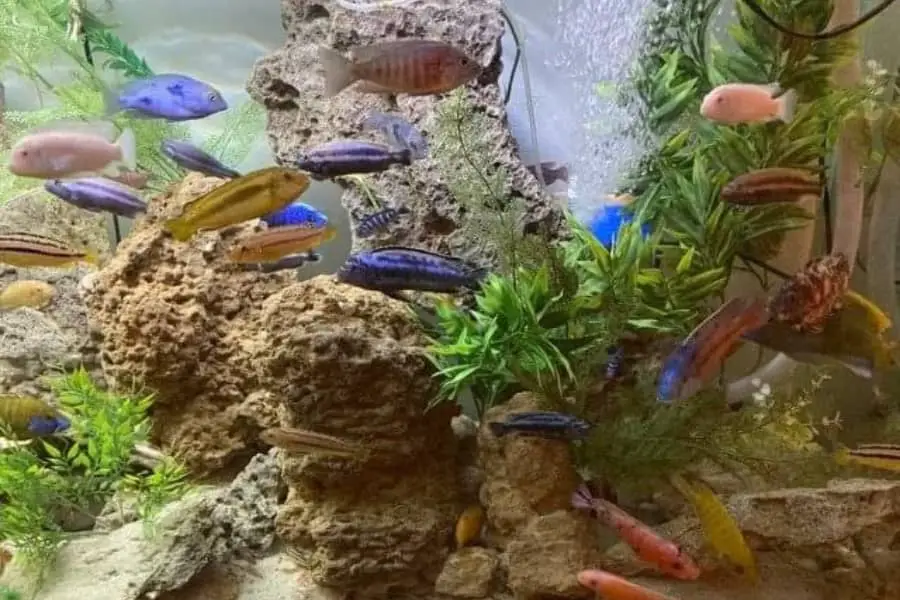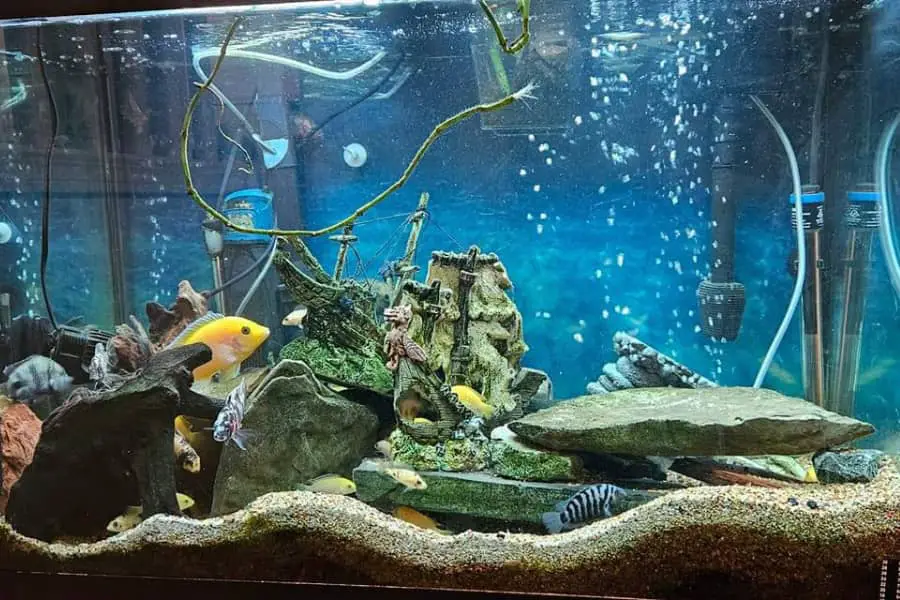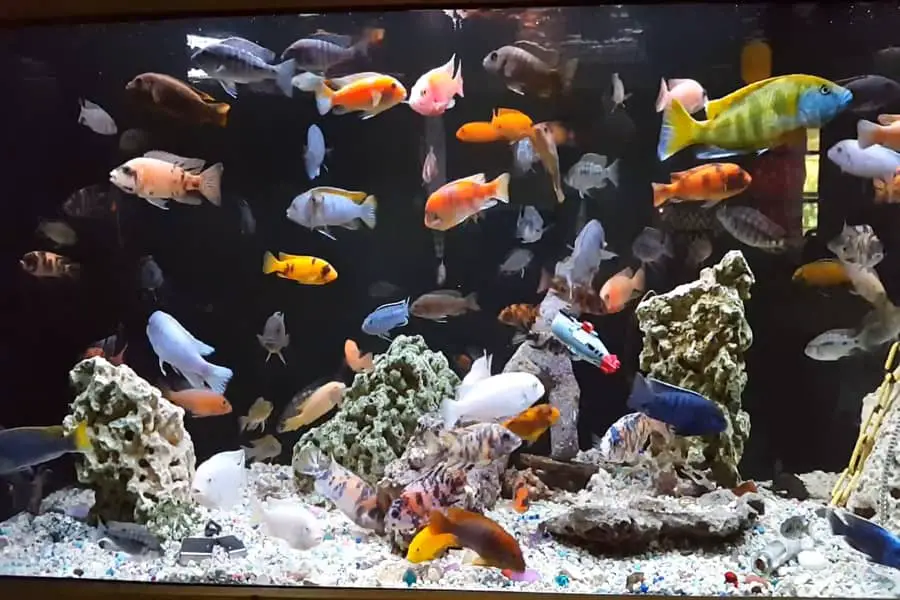How To Know If Your Fish Tank Is Overstocked?
When it comes to overcrowding, some blatantly label it as cruel, while others believe that pushing the stocking limit doesn’t hurt when you know how to do it the right way. Besides the “who’s right and who’s wrong” debate, the overarching question is how do you even define what an overcrowded tank is? How many fish are too many fish?
Even though there doesn’t seem to be a definite, universally applicable answer to this question, below we shared a few considerable factors to find out if your aquarium is overstocked. Also, if you want to know how to create healthy, liveable conditions in seemingly overcrowded tanks, this article is for you.
How To Know If Your Aquarium Is Overstocked?

Overcrowding can be a very subjective matter. It’s different for every person what they consider as overcrowded – based on their beliefs and experience running a tank. On top of it, each case is specific to the tank size, fish species, size and numbers, filtration, and maintenance practices.
Most importantly, you must realize that there is a spectrum, a range in overstocking. Instead of asking a binary question like, do I have an overcrowded aquarium or not, you should ask how overcrowded my tank is. Is it slightly overstocked, mildly overstocked, or heavily overstocked?
This is a catch, a nuance, which you have to keep in mind when determining whether your tank is overcrowded.
As you can see, there is no concrete answer to describe overcrowding. The one-size-fits-all approach doesn’t apply here. Unless you know the specifics of a particular case, it’s almost impossible to tell how many fish are enough fish for any size aquarium.
So does that mean there is no way to find out if your tank is overcrowded? Well, we didn’t say that either. The nearer you can get to know that is based on the factors shared below!
Water Quality Issues
If you are frequently experiencing the following water chemistry issues, you may have a higher bioload or an overcrowded tank.
- High ammonia/nitrite
- Fish gasping for air due to low oxygen levels
- Sludge buildup on the bottom of the tank
- Bacterial bloom caused by excess buildup of nutrition in the water
Another reason why you are having a hard time keeping the water quality up could be due to inadequate filtration and the failure to keep up with required water changes and other maintenance needs.
Limited Swimming Space
Now, even if you are able to maintain optimal water parameters without any issues, you still have to consider the actual space a fish needs to live and function optimally.
Keeping up with the maintenance and water quality is necessary but not enough. Your fish might survive, but it won’t thrive if squeezed into a smaller space – no matter how pristine the water quality is.
You must ensure the fish in the tank have plenty of room to comfortably turn around and swim normally as per their behavior. Cramped living conditions aren’t only inhumane but also take a toll on fish’s health and immune systems, making them susceptible to diseases.
What Happens When Your Equipment Breaks Down?
One method to find out if your aquarium is overcrowded is to consider the possibilities of equipment failure, power outages, and getting sick. Because let’s be honest, this can happen to anyone.
So, what happens if your filter stops working abruptly? You get the flu and can’t do water changes for days. Or there is a storm in your area that has caused a power outage, shutting down the filter and air pumps.
Do the fish start gasping at the surface after an hour? Do fatalities start to occur after 10 or 12 hours? If so, then your tank might be overstocked.
For example, considering a well-stocked aquarium, a filter’s job is to help keep the water quality up instead of being life support.
Is The 1-inch-per-gallon Rule a Good Estimation?
Often recommended to beginners, this rule particularly applies to small community fish with approximately 1-3 inches in size and not the larger ones.
For example, one 10-inch Oscar has more body volume than ten 1-inch Tetras, thus requiring more swimming space.
Also, the 1″/ gallon stocking rule becomes ineffective considering the fish that tend to stay at different levels in the tank such as top, mid, or bottom.
Can You Have a ‘Healthy’ Overstocked Aquarium?

An overstocked tank doesn’t necessarily mean an unhealthy environment. As previously mentioned, what matters is the degree to which your aquarium is overcrowded and whether you can handle the maintenance work that comes with it.
You can push the stocking limit as much as you want, as long as the water parameters remain stable and inhabitants aren’t cramped and have enough space to swim around.
So yes, overstocking in aquariums generally works when you know how to care for the tank and are actually willing to do what’s required.
Apart from that, here are some factors you should consider if you want to have a healthy, overstocked aquarium.
Species Matters
The type of fish you have in your tank matters a lot when overstocking is concerned. There are a few things you have to look into, including:
Swimming patterns: some fish are smaller in size (like Zebra Danios ) but are very active swimmers and require more swimming space to be able to exhibit their natural behavior. Whereas, larger ambush predator fish don’t move a lot and thus need less space.
For example, Bala Sharks are active swimmers, and therefore need larger tanks than Fire eels, despite being smaller in size.
Waste production: fish that eats a lot, poop a lot. As much as you can avoid “poop machines”, you will have reduced maintenance work and less chances of you running into water chemistry issues.
For example, large Goldfish produce a lot of waste, requiring more water changes and filtration.
Disease sensitivity: diseases spread quickly in crowded conditions due to the proximity between tankmates. For overstocked settings, it is best to avoid high-maintenance, ornamental fish that are highly prone to catching diseases.
Levels of The Tank
Fish that occupy different sections of the tank are ideal for overstocked aquariums.
For example, twenty Tetras in a 10-gallon tank are crowded as they are all middle dwellers. However, if you put 6 guppies (top dwellers), 10 Tetras (middle dwellers), and 4 Cory Cats (bottom dwellers), they are going to be fine.
Fish keeping Experience
Overstocking is not meant for beginners. It not only takes extra effort but is also expensive and requires a decent understanding of the hobby to make it work.
If you are a newbie fish-keeper, you shouldn’t entertain the idea of pushing the stocking limits because things can go south really quickly.
Most Effective Practices To Maintain Overstocked Aquariums

When it comes to running a healthy overcrowded tank, there are certain rules that one must abide by. When neglected, it puts your aquarium at a greater risk of crashes.
Heavy Filtration & Water Changes
To get rid of the waste build-up, dissolved organics, and waterborne hormones in overcrowded tank settings, you need robust filtration systems accompanied by extra water changes.
Overfiltration is the only way to ensure liveable conditions in overstocked aquariums. Ideally, go for a canister filter, one that is rated for a much larger tank, preferably double the size. If you don’t have a budget for that, get a smaller one and add a couple of sponge filters. Or you might consider installing 2 HOB filters at the opposite ends of the tank. Whatever suits you the best.
If you buy oversized filters, make sure they offer excellent flow control. Too strong water currents may cause constant distress to your aquatic pets.
Heavy filtration will help cut down on water changes, but you still have to do them religiously. You can determine the water replacement frequency for your tank based on bioload or nitrates production.
Lots of Beneficial Bacteria
You need large colonies of beneficial bacteria to break down toxic ammonia and nitrite levels taking place in overstocked settings.
Make sure you have plenty of surface area for lots of beneficial bacteria to nest. From filter media to hardscape in the tank can be utilized as an excellent breeding ground for these bacteria.
Higher Oxygen Levels
More fish in the tank means higher oxygen consumption. Depending on the type of filter you have and how much surface agitation it creates, you may or may not need additional equipment for oxygenation.
To ensure your tank has plenty of aeration all the time, put an airstone to work. Most importantly, get a battery-powered emergency air pump to prevent the risks of oxygen depletion during power outages.
Loads of Live Plants
Add as many live plants as you can manage in your overstocked aquarium. A heavily planted tank safeguards from nitrite spikes and absorbs excess nutrients. And who doesn’t like lush green aquascapes?
There are many different types of aquatic plants you can grow, such as Hornwort, Floaters, Salvinia, Wisteria, Java moss, Java fern, Anubias, Crypts, Bacopa, Pothos, etc.
Conclusion
Despite having so many variables involved, we have tried our best to give you a somewhat tangible answer to what overcrowding looks like in different scenarios. And how you can successfully run an overstocked aquarium efficiently while keeping your fish happy and healthy.
Lastly, we must put it out there that the well-being of the livestock should always be your highest priority rather than aesthetics.
